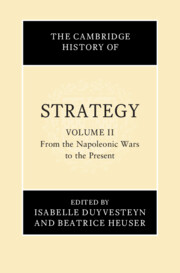Book contents
- The Cambridge History of Strategy
- The Cambridge History of Strategy
- The Cambridge History of Strategy
- Copyright page
- Dedication
- Contents
- Maps
- Contributors to Volume II
- Preface and Acknowledgements
- Introduction to Volume II
- 1 The Strategies of the Napoleonic Wars
- 2 Guerrilla and Nineteenth-Century Strategies of Insurgency
- 3 Russia, 1877–1917
- 4 The American Civil War
- 5 The Use of Naval Power
- 6 The Russo-Japanese War
- 7 Chinese Strategy, 1926–1949
- 8 First World War
- 9 Soviet Strategy, 1917–1945
- 10 Air Power
- 11 The Second World War in Europe
- 12 The Second World War in the Asia–Pacific
- 13 Soviet Strategy, 1945–1989
- 14 People’s War and Wars of Decolonisation
- 15 Nuclear Strategies
- 16 America’s Way of War
- 17 The Korean War
- 18 Israel’s Wars
- 19 The India–Pakistan Confrontations
- 20 The Yugoslav War, 1991–1999
- 21 Terrorism and Insurgency
- 22 The Forty-Year War in Afghanistan
- 23 The Three Gulf Wars and Iraq
- 24 China’s Wars, 1950–2021
- Conclusion
- Further Reading
- Index
10 - Air Power
Published online by Cambridge University Press: 06 January 2025
- The Cambridge History of Strategy
- The Cambridge History of Strategy
- The Cambridge History of Strategy
- Copyright page
- Dedication
- Contents
- Maps
- Contributors to Volume II
- Preface and Acknowledgements
- Introduction to Volume II
- 1 The Strategies of the Napoleonic Wars
- 2 Guerrilla and Nineteenth-Century Strategies of Insurgency
- 3 Russia, 1877–1917
- 4 The American Civil War
- 5 The Use of Naval Power
- 6 The Russo-Japanese War
- 7 Chinese Strategy, 1926–1949
- 8 First World War
- 9 Soviet Strategy, 1917–1945
- 10 Air Power
- 11 The Second World War in Europe
- 12 The Second World War in the Asia–Pacific
- 13 Soviet Strategy, 1945–1989
- 14 People’s War and Wars of Decolonisation
- 15 Nuclear Strategies
- 16 America’s Way of War
- 17 The Korean War
- 18 Israel’s Wars
- 19 The India–Pakistan Confrontations
- 20 The Yugoslav War, 1991–1999
- 21 Terrorism and Insurgency
- 22 The Forty-Year War in Afghanistan
- 23 The Three Gulf Wars and Iraq
- 24 China’s Wars, 1950–2021
- Conclusion
- Further Reading
- Index
Summary
Air power, with its capability for mass destruction, changed the face of twentieth-century inter-state warfare and redefined what power means. Having had limited impact on the First World War, the unique characteristics of air power – speed, height and reach – were immediately recognised as were its attributes: ubiquity, agility and concentration. Theorists explored the potential of this novel instrument for future wars, with one school emphasising strategic utility while another school explored its potential in the context of continental land warfare. Theory directly influenced the creation of air power capabilities and air warfare during World War II. While military technologies – in particular due to precision munitions – and societal attitudes concerning the use of force have changed, the theoretical foundations of the interbellum and the debates about the utility of air power still resonate. Today air power has become the icon of Western-preferred style of warfare, having demonstrated its potential utility not only in inter-state wars but also during humanitarian interventions and irregular warfare. Air power can pose or counter threats simultaneously, across a far wider area than surface capabilities, and quickly switch the point of application within and between operational theatres to create tactical and strategic effects.
- Type
- Chapter
- Information
- The Cambridge History of Strategy , pp. 204 - 225Publisher: Cambridge University PressPrint publication year: 2025

